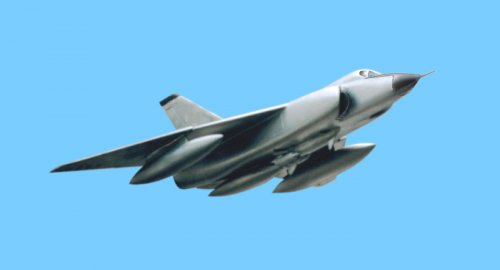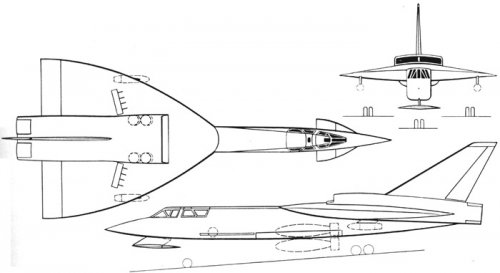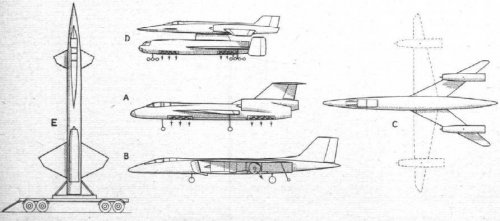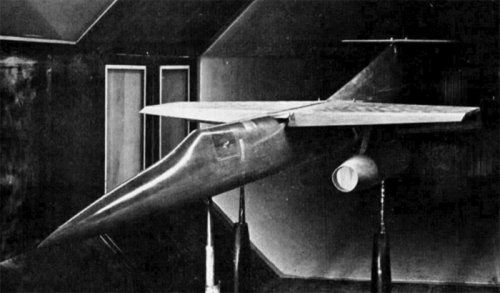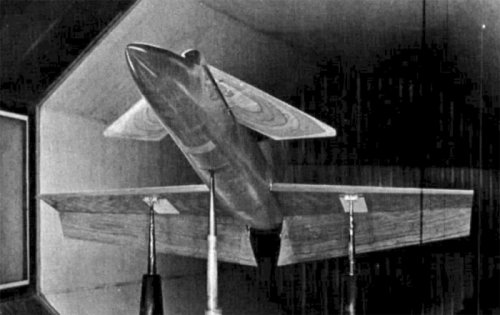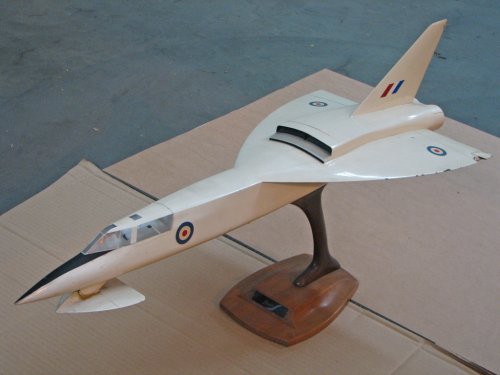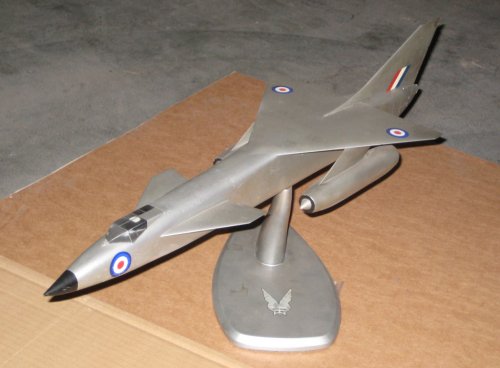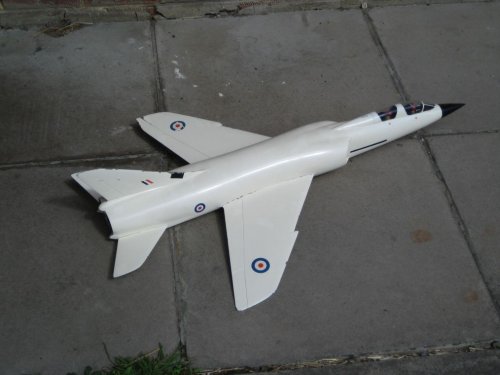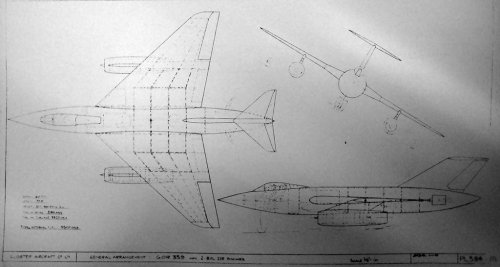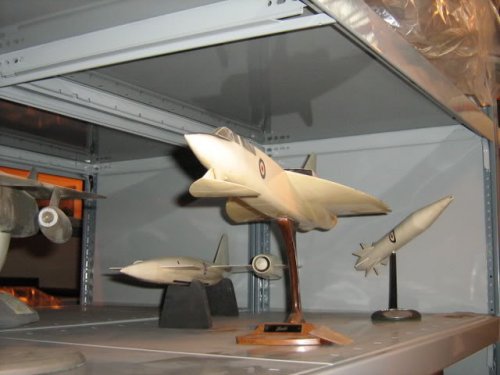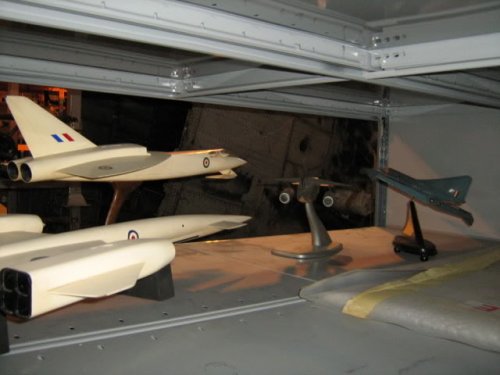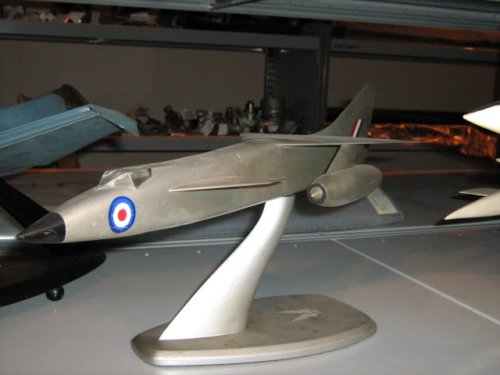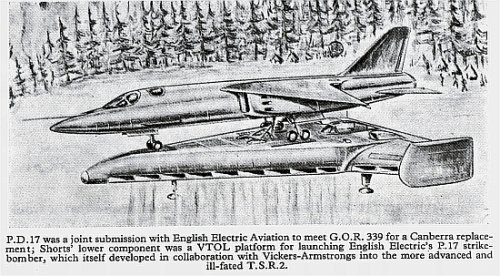DELETED POST (please remove from the thread)
You are using an out of date browser. It may not display this or other websites correctly.
You should upgrade or use an alternative browser.
You should upgrade or use an alternative browser.
GOR.339, OR.343, TSR.2 design proposals ...
- Thread starter TsrJoe
- Start date
- Joined
- 8 January 2006
- Messages
- 1,612
- Reaction score
- 765
- Joined
- 27 December 2005
- Messages
- 17,760
- Reaction score
- 26,522
While the GOR 339 submissions have been well illustrated by Tony Buttler, there are more details to be revealed.
Air Enthusiast August 1971
Source:A "TSR-2" from Bristol
When the British Air Staff drew up its General Operational Requirement (GOR) 339 for a Canberra replacement in 1957, eight airframe companies were invited to study the requirement and comment upon its feasibility. The chain of events then put in progress led eventually to the production, testing — and cancellation — of the TSR-2, one of the best-known aeroplanes of the 'sixties. Little has ever been published, however, about the other design submissions to GOR 339. One of the most interesting of these was the Bristol Type 204, a general arrangement drawing of which is published below for the first time anywhere.
Although Bristol was to become, in 1961, part of BAC and therefore indirectly associated with the TSR-2, the company was still independent at the time the Type 204 submission was made early in 1958. To achieve the required gust alleviation properties for low-level sorties at high subsonic speed, whilst retaining the stipulated take-off and landing performance, the Bristol design featured a version of the delta wing known as "gothic" (for its resemblance to a Gothic arch in plan view) plus a foreplane. The latter, also of gothic planform, was pylon-
mounted under the nose and was in two portions, with 10° upwards movement on the front portion and 40° downward movement on the rear section. Like the noseplanes now adopted for the Dassault Milan, the foreplane on the Type 204 helped to reduce the take-off and landing performance, which would otherwise have been excessive because of the use of a delta wing.
Type 204 had a crew of two in tandem, both pilot and navigator being provided with an excellent field of view. The navigation compartment, complete with seat, equipment and instruments, was separately suspended from the structure to provide additional damping of gusts during low-level flight.
Two 22,520 lb st (9 215 kgp) Bristol Olympus B Ol 22 turbojets with simplified reheat were mounted side-by-side in the rear fuselage, taking air through a "letter-box" intake above the wing. The primary weapon was to be a tactical megaton bomb (TMB) and weapon stowage was in an internal bay, with provision for bombs or rockets to be swung down clear of the fuselage before release. Wing pylons were provided for about 2,000 lb (900 kg) of rockets, rocket pods, or 200-gal (909l) drop tanks. Pro-
(Below) A model, and (above) general arrangement drawing of the Bristol Type 204.
vision was made for a flight refuelling probe and equipment included forwards and sideways looking radar and an APU.
The Type 204 had a max take-off weight of 78,000 lb (35 380 kg) and max landing weight of 50,000 lb (22 680 kg), with total internal fuel weight of 31,270 lb (14 184 kg). On this tankage, the radius of action was 875 nm (1 620 km), increasing to 1,000 nm (1 850 km) with drop tanks. Max speeds, as required by the specification, were Mach 0-95 at low level and Mach 20 at 35,000 ft (10 670 m). For a 1,000 nm (1 850 km) radius of action, the Type 204 required a 2,000 ft (610 m) take-off strip. Principal dimensions included: span, 32 ft 0 in (9,75 m); length, 79 ft 6 in (24,23 m); height, 20 ft 9 in (6,32 m); gross wing area, 820 sq ft (76,18 m2); aspect ratio, 1-25; foreplane span, 8 ft 5 in (2,57 m); foreplane area, 50 sq ft (4,65 m2).
Air Enthusiast August 1971
Attachments
- Joined
- 27 December 2005
- Messages
- 17,760
- Reaction score
- 26,522
September/October 1995 Air Enthusiast has an article on the competing designs for the British TSR.2 (GOR 339) program in the early 1960s.
I'm assuming you've read this article of course, Joe, but just in case.
I'm also assuming you've tried the Boulton Paul archives?
http://www.boultonpaul.com
Aparently it was a derivative of the "late" arrows such as the mk3, with the fieri air intakes...
The Douglas B-66 Destroyer ???
when one knows that the buccaneer was rejected because it didn't offer enhancement in performances compared to the Canberra... :
Proposed overseas types to fulfill GOR.339 specification, 1957 ;
Avro Canada ‘GOR.339’ Arrow Development ?
Bell D.188 VTO.
Convair B.58 Hustler
Douglas B.66 Destroyer
Republic F.105 Thunderchief
Martin B.68 delta (GOR.154)
North American A3J Vigilantie & Retaliator
The Douglas B-66 Destroyer ???
when one knows that the buccaneer was rejected because it didn't offer enhancement in performances compared to the Canberra... :
- Joined
- 11 March 2006
- Messages
- 8,627
- Reaction score
- 3,817
"P.202 1957
A Mach 1.8 executive aircraftfor 8 reaward facing passengersplus 3 crew,
3 tail mounted Bristol Orpheus BOR 12engines.AUW 50,000 lb. Lenght71 ft,
span 36 ft. Based on SR.177"
That's what's given by Tagg/Wheeler " From Sea to Air"
A Mach 1.8 executive aircraftfor 8 reaward facing passengersplus 3 crew,
3 tail mounted Bristol Orpheus BOR 12engines.AUW 50,000 lb. Lenght71 ft,
span 36 ft. Based on SR.177"
That's what's given by Tagg/Wheeler " From Sea to Air"
- Joined
- 27 December 2005
- Messages
- 17,760
- Reaction score
- 26,522
- Joined
- 29 September 2006
- Messages
- 1,798
- Reaction score
- 1,365
overscan said:Early English Electric GOR 339 design studies
Source:
PROJECT DESIGN OF COMBAT AIRCRAFT, B. O. Heath
AGARD-CP-62
That second pic looks a lot like the EE Bomber to the 'Avro 730' requirement. Strange they were considering the same design for GOR 339
- Joined
- 27 December 2005
- Messages
- 17,760
- Reaction score
- 26,522
Yep, the P.10.
In 1956 in the initial studies of a series finally leading to the TSR.2, efforts were made to relieve the weight and installation penalties of fuselage mounted engines: by then reheat was accepted as reliable, giving worthwhile economies overall but imposing detail constraints because of the associated higher jet velocities and temperatures. In an endeavour to revert to an earlier form of conventional solution, under wing nacelles were investigated [1st pic] with a tailplane raised above the jet efflux: however, even with an exaggerated ‘T’ tail (which needed bracing in the wind tunnel) undesirable pitch-up still occurred and the layout was dropped.
The most unconventional arrangement was then evaluated: this was a tail-first configuration with ‘conventional’ (i.e. wide-coupled) canard to wing spacing, on which a divergent chase between control requirements for nose lifting and stability followed. [2nd pic]. The need for the canard to stall after the wing inhibited the total low speed lift to be secured offsetting to some extent the direct benefit of the upwards trimming force from the canard. Although S.T.O.L. was needed, increases in wing area were not desirable because of gust response at low altitude and high speed and this approach was discarded.
Sentinel Chicken
American 71 Heavy, contact departure 126.47
Do the dorsolateral intakes also feed the third ventral engine? I can't quite out if there's a third intake somewhere that I'm not seeing.TsrJoe said:Saunders Roe P.202 in passenger configuration ...
W
Wingknut
Guest
Sorry if this is already known to you all, but Martin Letts' "x-planes" site has some fine CGI-renderings of the Fairey canard proposal for GOR.339. See: http://www.xplanes3d.com/Projects%20Pages/GOR339/GOR339_Thumbs.html
- Joined
- 27 December 2005
- Messages
- 17,760
- Reaction score
- 26,522
Gloster were supposed to study a VTO version of GOR 339, as per Hawker Group meeting notes.
- Joined
- 29 September 2006
- Messages
- 1,798
- Reaction score
- 1,365
flateric said:Oh, my...this is incredible stuff coming today!
Super stuff Joe! And my, doesn't the Shorts initial design look so much like the finished product!
- Joined
- 27 December 2005
- Messages
- 17,760
- Reaction score
- 26,522
- Joined
- 27 December 2005
- Messages
- 17,760
- Reaction score
- 26,522
- Joined
- 27 December 2005
- Messages
- 17,760
- Reaction score
- 26,522
- Joined
- 27 December 2005
- Messages
- 17,760
- Reaction score
- 26,522
- Joined
- 27 December 2005
- Messages
- 17,760
- Reaction score
- 26,522
Merged some duplicate topics
red admiral
ACCESS: Top Secret
- Joined
- 16 September 2006
- Messages
- 1,817
- Reaction score
- 2,403
Awesome pictures from TSRJoe that I hadn't seen before.
A few more pictures of the models residing at RAF Stafford;
http://i25.photobucket.com/albums/c84/AviationImages/RAF%20Stafford/Avro730Bristol204Fairey339EEP10.jpg
http://i25.photobucket.com/albums/c84/AviationImages/RAF%20Stafford/Bristol204.jpg
http://i25.photobucket.com/albums/c84/AviationImages/RAF%20Stafford/Fairey339.jpg
A few more pictures of the models residing at RAF Stafford;
http://i25.photobucket.com/albums/c84/AviationImages/RAF%20Stafford/Avro730Bristol204Fairey339EEP10.jpg
http://i25.photobucket.com/albums/c84/AviationImages/RAF%20Stafford/Bristol204.jpg
http://i25.photobucket.com/albums/c84/AviationImages/RAF%20Stafford/Fairey339.jpg
Attachments
- Joined
- 20 January 2007
- Messages
- 953
- Reaction score
- 1,143
Joe: I've no doubt there's more to come on TSR.2. Dim brainrecess has me in MoA F-111K London Project Office 1966 with Airfix-sized models on cabinets and strung about. Said to be pre-BAC TSR.2. One was a piggy-back.
Experimental teams are not above passing time with what-ifs, though. Cathay Pacific's Engineering Director had a Boeing model in 1988-or-so best described as a 767/757 piggy-back. He told me never a real intention to proceed, but was a spoiler to buy time (for what became 777) and deter Cathay from buying an Airbus product.
Experimental teams are not above passing time with what-ifs, though. Cathay Pacific's Engineering Director had a Boeing model in 1988-or-so best described as a 767/757 piggy-back. He told me never a real intention to proceed, but was a spoiler to buy time (for what became 777) and deter Cathay from buying an Airbus product.
hole in the ground
ACCESS: Secret
- Joined
- 6 August 2008
- Messages
- 235
- Reaction score
- 23
a double gnat! ;D
- Joined
- 28 November 2006
- Messages
- 712
- Reaction score
- 738
TsrJoe said:iv recently found the 'Gnat tactical bomber' brochure put together by W. Petter as a counter to the all singing all dancing GOR.339, ill scan and post up the ga. drawing for completeness
I cannot wait for its drawing and specifications.
BTW, it's interesting why Tony Butler in his book on jet bomber secret projects doesn't say even a word about the Folland design.
Best regards,
Piotr
- Joined
- 11 March 2006
- Messages
- 8,627
- Reaction score
- 3,817
Many thanks for the Gnat bomber, although it sends me back to the "drawing board" .. 
(http://www.secretprojects.co.uk/forum/index.php/topic,449.0/highlight,folland+bomber.html)
Span is larger, but the wheelbase is shorter, than I expected from the perspective drawing
in "Sabre Slayer And Red Arrow". The wheelbase indeed seems very short to me, with the ain gear
just at half the fuselage length. Are there exact length and/or span data on the drawing ?
(http://www.secretprojects.co.uk/forum/index.php/topic,449.0/highlight,folland+bomber.html)
Span is larger, but the wheelbase is shorter, than I expected from the perspective drawing
in "Sabre Slayer And Red Arrow". The wheelbase indeed seems very short to me, with the ain gear
just at half the fuselage length. Are there exact length and/or span data on the drawing ?
- Joined
- 28 November 2006
- Messages
- 712
- Reaction score
- 738
TsrJoe said:some specifications for the 'Gnat Tactical Bomber' taken from the brochure are ..
Could you please tell us what engines the Gnat Tactical Bomber was to have (a version of the Orpheus)? Does the brochure say anything about its armament?
As for the GOR.339 projects, as far as I understand, most of designs submitted to the requirement were supersonic (not at low level, obviously). The Folland's bomber was subsonic, wasn't it? Do you have any details of its projected performance?
Best regards,
Piotr
danielgrimes
ACCESS: Confidential
- Joined
- 8 October 2007
- Messages
- 57
- Reaction score
- 12
Petrus said:most of designs submitted to the requirement were supersonic (not at low level, obviously).
2 Olympus 320s pushing out 61,000lbs with reheat would have every design supersonic - even a brick!! (F-111A could only muster 33,000lbs)
- Joined
- 18 March 2008
- Messages
- 3,529
- Reaction score
- 999
Don't know what F-111 you are referring to there but the TF-30 that powered all of them could provide up to 25,000 lbs with reheat, 17,000 lbs dry. Not quite in the Olympus league but a lot more than only "33,000 lbs" (which I assume is the combined thrust of two TF-30s dry).
danielgrimes
ACCESS: Confidential
- Joined
- 8 October 2007
- Messages
- 57
- Reaction score
- 12
Abraham Gubler said:Don't know what F-111 you are referring to there but the TF-30 that powered all of them could provide up to 25,000 lbs with reheat, 17,000 lbs dry. Not quite in the Olympus league but a lot more than only "33,000 lbs" (which I assume is the combined thrust of two TF-30s dry).
Don't know what happened to adding two numbers together - 53,650lbs! for the F-111A & E ;D
- Joined
- 2 January 2006
- Messages
- 659
- Reaction score
- 284
Petrus said:TsrJoe said:some specifications for the 'Gnat Tactical Bomber' taken from the brochure are ..
As for the GOR.339 projects, as far as I understand, most of designs submitted to the requirement were supersonic (not at low level, obviously).
AFAIK the requirement was MAch 2.2 dash at altitude and Mach 1+ at sea level.
G
- Joined
- 28 November 2006
- Messages
- 712
- Reaction score
- 738
AFAIK the requirement was MAch 2.2 dash at altitude and Mach 1+ at sea level.
G
This is precisely what I meant.
Back to the Folland project, I think not only was it (most probably) subsonic at all altitudes, but also - being quite a small and light aircraft - lacked all sophisticated avionics (side-looking radars, navigational aids and so forth) that had appeared in designs submitted to the GOR.339 and then equipped the TSR.2. I wouldn't be surprised if Folland regarded the project rather as an offer to foreign air forces (Indian? South African? maybe some Latin American?) than as a serious submission to the RAF requirement. Which, as for me, makes the project even more fascinating.
All the best,
P.
- Joined
- 21 May 2006
- Messages
- 3,003
- Reaction score
- 2,287
TsrJoe said:Vickers (Wallis) GOR.339 submission (Swallow derivative)
Interesting drawing TsrJoe
Do you have the full 3-view drawing (head-on view) ????
Regards
Pioneer
Hammer Birchgrove
ACCESS: Top Secret
- Joined
- 13 May 2009
- Messages
- 583
- Reaction score
- 45
Imagine how controversial it would be if RAF had bought the B-58. Now that was an expensive aircraft.Archibald said:Aparently it was a derivative of the "late" arrows such as the mk3, with the fieri air intakes...
Proposed overseas types to fulfill GOR.339 specification, 1957 ;
Avro Canada ‘GOR.339’ Arrow Development ?
Bell D.188 VTO.
Convair B.58 Hustler
Douglas B.66 Destroyer
Republic F.105 Thunderchief
Martin B.68 delta (GOR.154)
North American A3J Vigilantie & Retaliator
The Douglas B-66 Destroyer ???
when one knows that the buccaneer was rejected because it didn't offer enhancement in performances compared to the Canberra... :
Skyraider3D
Aviation Artist
Awesome stuff!! B)
That 70(!)-engined aircraft platform thingy is sheer lunacy! ;D
;D
That 70(!)-engined aircraft platform thingy is sheer lunacy!
- Joined
- 27 December 2005
- Messages
- 17,760
- Reaction score
- 26,522
571 1 shows clear ancestry from the Type 559. Nice piccies!
Anyone know what kind of thrust figures were being banded around at the time for the RR RB.142R engines which were pitched for a lot of these designs?
Also as a side note, anyone know how much of a study was done in the early 80's to resurrect the TSR.2? I know there was a general look at the viability but how much technical assesment was done, especially in the engine department as Olympus technology had moved on quite a bit by then (over 40,000lb dry which was in the pipeline for Concorde before ongoing development funds were cut, though geared for hi altitude efficiency) or was a move to turbofan looked at (originally an option anyway). ? Any info would be interesting as it is quite hard to find out any specifics other than a project was initiated into looking about bringing the TSR.2 back.
Also as a side note, anyone know how much of a study was done in the early 80's to resurrect the TSR.2? I know there was a general look at the viability but how much technical assesment was done, especially in the engine department as Olympus technology had moved on quite a bit by then (over 40,000lb dry which was in the pipeline for Concorde before ongoing development funds were cut, though geared for hi altitude efficiency) or was a move to turbofan looked at (originally an option anyway). ? Any info would be interesting as it is quite hard to find out any specifics other than a project was initiated into looking about bringing the TSR.2 back.
- Joined
- 20 January 2007
- Messages
- 953
- Reaction score
- 1,143
In the 1980s...a project was initiated into looking about bringing the TSR.2 back. Surely this is a canard (Ha!). Ex-BAC TSR.2 team members Freddie Page/B.O.Heath, now BAe. seniors, were preoccupied with deployment of Tornado and with the Saudi side of that programme, upon which BAe. was utterly dependent. Just what benefit, to anybody, could be inferred in resurrecting a 1958 notion, long superseded in avionics, structures, aerodynamic technologies? What could a Vulcan-sized nuclear strike/recce type do that Tornado (and applications from the EAP/ACA studies, to become Typhoon) could not?
Similar threads
-
BAC TSR.2 bomb bay and weapons configuration drawings
- Started by Pioneer
- Replies: 11
-
-
-
Folland Gnat - Development & Derivatives
- Started by TsrJoe
- Replies: 101
-
Fairey Tactical Strike Aircraft GOR.339 Project 75
- Started by Welshy42
- Replies: 12

